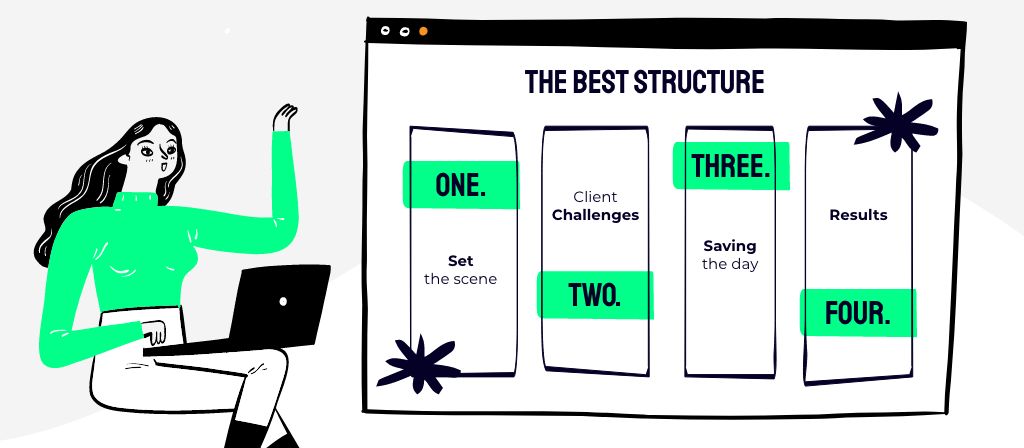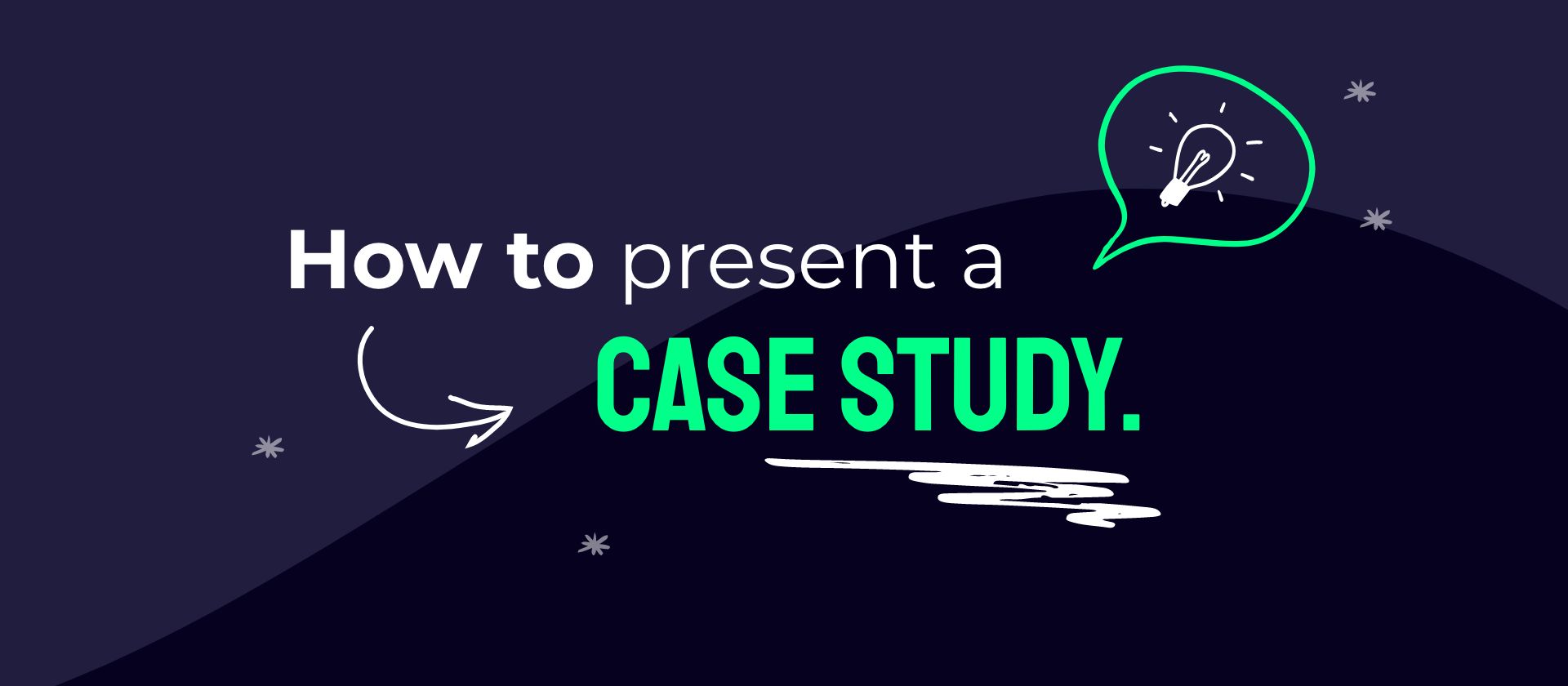You’ve been following Buffalo 7’s wisdom for some time, and know all about your audience’s challenges and how you can solve them. But how do you prove it? By learning how to present a case study, that’s how.
What’s the point of a case study in a presentation?
The point of a case study is to constructively toot your own horn. It’s one of the few places where you can properly begin to talk about all the great stuff you do in your work, without coming across like an egotistical nightmare. Case studies in your presentation can be used to get your audience excited about working with you. And to demonstrate that you can be trusted – that you’ve been there, done that, and got the undeniable results.

In fact, 78% of B2B buyers use case studies as an integral part of their pre-purchase research. And the best way to harness this power, using it to your advantage, is to advertise your greatest achievements in a way that resonates with your audience. It’s a very fine line to tread between credible and braggadocious. But that’s where we can help.
How to present a case study with emotion.

If you can get your audience to see themselves reflected in your case studies, you’re onto a winner. Once a prospect can picture themselves playing the part of your customer – and all the benefits that brings – a healthy dollop of sunk cost bias will nudge them safely over the line.
There are other benefits of publishing case studies too. A powerful case study fosters an atmosphere of positive social proof, which is crucial for any brands struggling with their image. Think of satisfied customers as an extra division of your marketing department, just sitting and waiting to be put into action.
When should I use a case study in a presentation?
Lots of companies choose to sequester their studies away on their website and hope curious prospects will stumble upon them. We think that’s a waste of a good boasting opportunity. You can benefit from pulling a well-written case study out of the bag at loads of marketing milestones.
Consider including case studies in places like: persuasive one-off prospect pitches, slick ongoing sales decks, wallet-opening investor presentations, lead-generating marketing presentations, and spotlight-grabbing conference presentations. Basically, almost any presentation you can think of will benefit from a little case study credibility, helping your audience to visualise how great it’ll be to work with you.
What to include in a case study presentation.

All the best case studies feature a cunning blend of figures and feelings. But the real impact comes right from the horse’s mouth. If possible, tell your case study story from your client’s point of view. Ask them for just half an hour of their time. Talk with them about their day-to-day lives before working with you. Ask how the process was for them. And, of course, talk about their new world and how much better it is now.
It’s nothing personal, but your audience is much more likely to believe the results, if someone else is telling them.
But once you have that information from your client, how do you turn it into a story? We know, we know – we harp on about storytelling all the damned time. But the importance of utilising narrative structure here can’t be understated. And it’s really easy to do.
What’s the best case study structure?
There are no hard and fast rules when it comes to the structure of your case study presentation. Every client journey is unique, so – when you present your case study – you should reflect that. Having said that, there are some key ingredients that most case studies need to include to have the greatest impact. And following a set structure just makes the whole thing a lot easier, eh?
- Set the scene
Pique your audience’s interest with an emotional hook, setting the scene and getting them invested in the client story.
Who is the client you’re talking about? What industry do they sit inside? Why should your audience care? Is there any relevant history that your audience could benefit from hearing?
- What challenges darkened their door?
Why did they need to hire you? What difficulties were they facing before you came along – either personally or across their industry? Did they have a specific goal they wanted to achieve, with your help?
- How did your solution save the day?
What were you able to bring to the table that nobody else could? What unique approach did you use to find your angle of attack?
One ballsy approach could be to outline any parts that went pear shaped, and how you fixed them. We learn the most valuable lessons rectifying the chaos of a mistake. There’s a certain charm in owning up to your mistakes that will humanise you to your audience. And that never hurts when you’re trying to get them to buy into your service. Just make sure you don’t forget to tell them what you learned, and what’s in place now to ensure it will never happen again.
- Rustle up some results
Once you’ve grabbed their attention, drive the weight of the case study home with transformational facts and figures. Demonstrate the real and measurable change your client was able to effect with you by their side.
Are there any tangible stats you can fling into the faces of your audience members? An increase in traffic? An uptick in sales? A boost in brand visibility?
If you don’t have any substantial stats, you could frame a picture of the future using the results your service has provided as a springboard. Just make sure to keep them grounded in reality.
When’s the best time to present my case study?
Again, every audience – and every presentation – is different, but – 90% of the time – the best place for a case study is towards the end of your presentation. By this point, you’ll have pulled on their emotional responses, shown you have a solution that their gut says is perfect for them, but they’ll be looking for something credible to seal the deal.
Try to move seamlessly from presenting the solution to backing it up with a relevant case study. And you may want to think about including one case study per solution, so that you’re never lacking for proof points.
How to present a case study slide.
You’ve written your case study story. You know where it’s going to go in your deck. Now you just need to build the thing.
Remember that all your presentation principles should still hold true for this portion of your deck. Stick to one big idea per page, minimal on-slide copy, engaging visuals, and rich detail hiding inside the speaker notes.
Your case study may warrant one slide per stage of the structure. Or all four stages might be more impactful on one. It all depends on how many ideas you’re trying to communicate, and how overwhelming it all could be if smushed together.

How to present an interactive case study.
We think every presentation should be as interactive as possible. And if you use PowerPoint as your vehicle for presenting social proof, it’s a breeze to ease in audience participation.
Rather than just dumping all your case studies onto the testimonials page of your site, you can create a menu in PowerPoint and let your audience choose which study they want to know more about. Or, if they’re not sure, you can use this opportunity to show your understanding of their world and pick for them.

Using the same case study in multiple places.
You can get the most mileage out of your marketing by utilising case studies in multiple ways. It’s best practice to have the cut-down, conversational versions a part of your pitch decks, with more static, text-heavy versions on your website.
You could even take the same assets and create marketing videos for platforms like LinkedIn, Instagram, YouTube, or TikTok – depending on the viewing habits of your prospects.
The important thing here is to keep all the iterations of your case studies up to the same impeccable standard. You should be able to craft a narrative flow for your audience whether they’re actively being presented to, left to read through a written case study, or browsing through video versions of your testimonials.
And that means creating bespoke case study presentations, not just using a rubbish template.
Where to find the best case study templates.
If we’re being brutally honest, there isn’t a good PowerPoint case study template anywhere. And that’s because every case study is totally unique. The value of a good case study lies in the personalised journey that it takes your audience on.
Basically, if you want to make an impact, you can’t cut corners. You need to learn how to spot the most emotively accessible story arc in any study. Once you’ve got that nailed down, you can adapt your own bespoke PowerPoint template to tell that story, and it’ll be better – and more on brand – than any downloadable template you can find online.
And, once you’ve nailed storytelling for case studies, you’ll be able to apply this new-found skill to any persuasive communication. In other words, you’ll be unstoppable.


